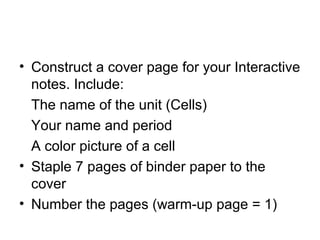
Cell discovery
- 1. • Construct a cover page for your Interactive notes. Include: The name of the unit (Cells) Your name and period A color picture of a cell • Staple 7 pages of binder paper to the cover • Number the pages (warm-up page = 1)
- 2. Cell Discovery (pg 2)
- 3. Cell Discovery (pg 2) • Cell = Basic unit of life (building blocks of life)
- 4. Cell Discovery (pg 2) • Cell = Basic unit of life (building blocks of life) • Robert Hooke: 1665 Observed cork (dead plant cells) and called the little boxes he saw “cells”
- 5. Cell Discovery (pg 2) • Cell = Basic unit of life (building blocks of life) • Robert Hooke: 1665 Observed cork (dead plant cells) and called the little boxes he saw “cells” • Anton van Leeuwenhoek: 1675 First observed living cells
- 6. Cell Discovery (pg 2) • Cell = Basic unit of life (building blocks of life) • Robert Hooke: 1665 Observed cork (dead plant cells) and called the little boxes he saw “cells” • Anton van Leeuwenhoek: 1675 First observed living cells • Schleiden, Schwann, and Virchow (1838- 1855) Developed the Cell Theory
- 7. Cell Theory 1. All organisms are composed of one or more cells
- 8. Cell Theory 1. All organisms are composed of one or more cells 2. The cell is the basic unit of organization in all organisms
- 9. Cell Theory 1. All organisms are composed of one or more cells 2. The cell is the basic unit of organization in all organisms 3. All cells come from other cells
- 10. 2 Types of Cells • Prokaryotic cells: No nucleus. No organelles besides ribosomes. Bacteria and Archaea
- 11. 2 Types of Cells • Prokaryotic cells: No nucleus. No organelles besides ribosomes. Bacteria and Archaea • Eukaryotic cells: contain nucleus and organelles. Animals, plants, fungi, protists
- 12. Output (pg 3) • Draw 3 color pictures to help you remember the 3 parts of the cell theory • Number the pictures 1,2, and 3 so you can tell which picture goes with which part of the theory